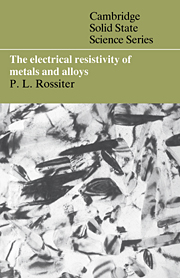Book contents
- Frontmatter
- Contents
- Preface
- 1 Basic concepts
- 2 Atomic configuration of an alloy
- 3 The structure of magnetic materials
- 4 Electrons in simple metals and alloys
- 5 Electrical resistivity of simple metals and alloys
- 6 Non-simple, non-magnetic metals and alloys
- 7 Magnetic and nearly magnetic alloys
- 8 Other phenomena
- Appendices
- References
- Index
5 - Electrical resistivity of simple metals and alloys
Published online by Cambridge University Press: 07 January 2010
- Frontmatter
- Contents
- Preface
- 1 Basic concepts
- 2 Atomic configuration of an alloy
- 3 The structure of magnetic materials
- 4 Electrons in simple metals and alloys
- 5 Electrical resistivity of simple metals and alloys
- 6 Non-simple, non-magnetic metals and alloys
- 7 Magnetic and nearly magnetic alloys
- 8 Other phenomena
- Appendices
- References
- Index
Summary
We now want to consider the electrical resistivity of simple metallic alloys in terms of the pseudopotential formalism developed in Chapter 4 for the scattering potential and using the methods developed in Chapter 2 to describe the structure of the alloys of interest. In most cases we will assume that this scattering process can be adequately described in terms of the relaxation time approximation discussed in Chapter 1. Some of the alternative methods which are applicable to non-simple metals are discussed in Chapter 6, although it is noted that these are equally suited to the study of simple metals as evidenced by some of the examples discussed in that chapter.
The alloy features that can be considered within this framework include atomic correlations and their associated static atomic displacements, vacancies and interstitials and their associated static atomic displacements and thermally induced displacements. Of these, the effects of atomic correlations, vacancies, interstitials and their associated displacement fields are dealt with directly in terms of the deviation lattice described in Chapter 4. This is because the defects are adequately described in terms of the site occupation parameters (or their averages) and the scattering potentials can be expressed in terms of a deviation from the average potential. In the case of atomic correlations this is just the difference in the atomic form factors wA(r) — wB(r).
- Type
- Chapter
- Information
- The Electrical Resistivity of Metals and Alloys , pp. 137 - 271Publisher: Cambridge University PressPrint publication year: 1987
- 8
- Cited by



